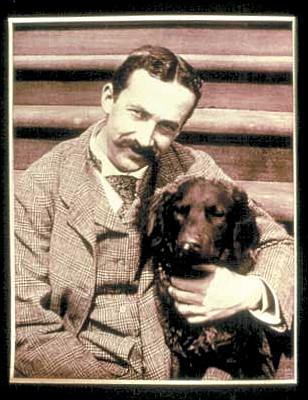The Mercer Museums: Fonthill, Moravian Pottery, and More – The Journal of Antiques and Collectibles – March 2004
Henry Chapman Mercer
Henry Chapman Mercer is a legend in Bucks County Pennsylvania. An historian, archaeologist, collector, and ceramist, Mercer left a collection of pre-Industrial antiques and collectibles ? as well as a lifestyle and an art form ? despite the pressures of modernism working against him. His legacy and its four unusual buildings can be found along a stretch of road in Bucks County now known as the Mercer Mile.
Born in 1856 in Doylestown, Mercer studied law and ancient history at Harvard University. He had an illustrious and respected career after he graduated. He served as curator of American and pre-historic archaeology at the Museum of the University of Pennsylvania from 1894 to 1897, and he oversaw excavations in the Yucatan Peninsula and in the Delaware, Ohio and Tennessee River valleys.
But his goals changed in 1897, when, while rummaging around a shed, he stumbled on a series of tools recently left obsolete by the newly burgeoning Industrial age. Believing that the pre-1850 tools might one day be a treasure for some future archeologists, he decided to preserve them. While everyone else at the time was tossing these kinds of objects away, Mercer went against the grain and started collecting them. He was convinced that if he did not, they would be all but lost to history.
The Mercer Museum
Mercer’s collection grew in size and scope over the next decade. Eventually he needed a museum to display it. With little support from museums who thought his items were of little use, he decided to build his own. Construction of what would become the Mercer Museum began in 1913. Completed three years later, the building was not typical of construction at the time. Rising six stories high, the museum is built entirely of concrete reinforced with iron rods and mesh. Although concrete construction is more common now, his was a remarkable decision at the time. Mercer opted for the material because of its plasticity and fireproof properties ? features that he knew would protect his treasures for years to come.
Now, more than 60 percent of the museum’s 50,000 artifacts, ranging from clock making tools to a conestoga wagon, are exhibited in the concrete building (see photographs on page 38). More than 60 early American trades (including cider making, black-smithing, printing, needlework, shoemaking, and farming) are represented. Among the oldest artifacts in the museum collection are a whale oil lamp over 2,000 years old, and Native American implements dating back between 6,000 to 8,000 B.C.
The Mercer Museum was designated a National Historic Landmark in 1985, and a gallery was opened in 1989 to house changing exhibitions. Today the museum gets more than 80,000 visitors each year.
The museum is locatd at 84 South Pine Street in Doylestown, PA. For more information, call (215) 345-0210 or visit www.mercermuseum.org.
The Fonthill Museum
The Mercer Museum was an accomplishment in itself, but 52-year old Mercer had more projects underway. Between 1908 and 1912, he built Fonthill as his home. Also constructed of concrete, the castle has 44 rooms, 18 fireplaces, and more than 200 windows. The interior walls, floors, and ceilings are elaborately adorned with an array of Mercer’s original handcrafted tiles (we will get a view of his tile work later in this article) as well as Persian, Chinese, Spanish, and Dutch tiles he had collected.
Like the Mercer Museum, Fonthill was remarkable in just about every way. Equipped with two dumbwaiters, an Otis elevator, an intercom buzzer system, and phones to communicate within the house, the castle had built-in book cases made to display Mercer’s 6,000 volumes. He also placed more than 900 prints on the walls.
After Mercer’s death, Fonthill was operated by a separate Mercer/Fonthill Trust. Since 1976 the Bucks County Historical Society has administered Fonthill, and in 1990 the two governing boards were merged. A variety of programs are offered to the public including regular guided tours, special “behind-the-scenes” tours, programs specifically geared to students, holiday events, and murder mysteries.
Fonthill, designated a National Historic Landmark in 1975, has more than 30,000 visitors each year and is maintained by a corps of 40 volunteers.
The museum is locatd at East Court Street and Route 313 in Doylestown, PA. for more information, please call (215) 345-0210 or visit www.fonthillmusuem.org.
Mercer and the Moravian Pottery & TileWorks
Mercer established the Moravian Pottery and Tile Works about 100 years ago in an effort to duplicate the work of Pennsylvania German potters, a craft that he was attempting to preserve along with his collection of tools and artifacts.
Designed by Mercer and built of hand-mixed reinforced concrete in 1911 and 1912 under his supervision, the tile factory replaced his original and much smaller pottery located in another part of Doylestown, on the Mercer family estate. Turning from pottery to tiles, he found success after much experimentation. His handcrafted tiles were an important example of functional and decorative products made within the Arts & Crafts Movement, popular between 1885 and 1925.
Mercer had already established the Tile Works as a business operating out of his first pottery in 1898, the same year he completed and sold his first order of “Moravian” tiles. It was there, too, that he produced his most notable installation of tiles for the new State Capitol building in 1906. Other prominent commissions included tiles for the West Point Academy, the John D. Rockefeller Estate, the Gardner Museum, the Boston Museum of Fine Arts and Washington’s National Press Club.
After Mercer died in 1930, tile production continued under a succession of owners. In 1964 the County of Bucks began the process of obtaining, through eminent domain, the Moravian Pottery and Tile Works, which was at that time operating on a small scale with sales of tiles and tours offered to visitors. Five years later the site opened for public visitation under the administration of the Bucks County Department of Parks and Recreation. Once the County did open it as a museum, an interest in reviving tile production took hold, and in 1974, tile production began again following Mercer’s original processes as faithfully as possible.
Today the site is recognized as a National Historic Landmark and operates as a working history museum, producing reissues of Mercer’s original line of tiles, which are available through the Tile Works’ tile shop. Open seven days a week, the Tile Works also offers tours of the museum, educational programs in ceramics, and a membership program.
Today’s visitors to the museum can take a tour consisting of a 17 minute video on Mercer, his history and his tile making techniques, and then take a self-guided walk through the building to see the unique architecture, displays and tile making demonstrations. The shop carries an assortment of Mercer’s original line of tiles and mosaics, popular with county residents, tourists and purchased by notable personalities such as Keith Richards, Arnold Palmer, Mario Andretti and Deborah Winger. Joan Mondale, on a visit, purchased some and Presidents Reagan and Ford were presented with commemorative tiles.
The Tile Works is located at 130 Swamp Road (Route 313), midway between Routes 611 and 202. For additional information, call (215) 345-6722 or visit www.buckscounty,org .
The Spruance Library
Part of the Mercer Mile is the Spruance Library. Founded in 1880, the Bucks County Historical Society collects, preserves, and interprets the history and culture of Bucks County and the Delaware Valley region. The society’s Spruance Library is the major research center for local and family history related to Bucks County and surrounding regions. Library collections also focus on two related subject areas: early American technology, culture, and folk art; and the life and work of Mercer.
The library was named for F. Palin and Helen S. Spruance in 1978, benefactors and lifelong members of the Bucks County Historical Society. It is housed within the Mercer Museum and offers a library staff and volunteers to help visitors. All collections are used within the library and do not circulate, but photocopying and photographic reproductions are available, with some restrictions.





Related posts: